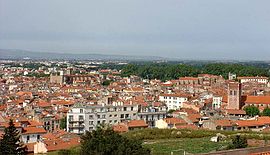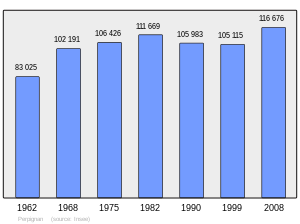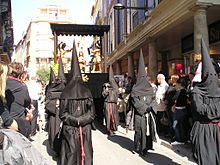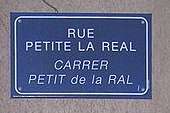Perpignan
Perpignan
| |
|---|---|
 Perpignan seen from the Palace of the Kings of Majorca | |
|
| |
| Country | France |
| Region | Occitania |
| Department | Pyrénées-Orientales |
| Arrondissement | Perpignan |
| Intercommunality | Têt Méditerranée |
| Government | |
| • Mayor (2009–2014) | Jean-Marc Pujol (UMP) (Radical-UMP) |
Area 1 | 68.07 km2 (26.28 sq mi) |
| Population (2013) | 118,238 |
| • Density | 1,700/km2 (4,500/sq mi) |
| Demonym | Perpignanais |
| Time zone | UTC+01:00 (CET) |
| • Summer (DST) | UTC+02:00 (CEST) |
| INSEE/Postal code | 66136 /66000 |
| Elevation | 8–95 m (26–312 ft) (avg. 30 m or 98 ft) |
| Website | www.mairie-perpignan.fr Template:Fr icon www.ajuntament-perpinya.cat Template:Ca icon |
| 1 French Land Register data, which excludes lakes, ponds, glaciers > 1 km2 (0.386 sq mi or 247 acres) and river estuaries. | |
Perpignan (French: [pɛʁ.pi.ɲɑ̃]; Template:Lang-ca [pərpiˈɲa]) is a city, a commune, and the capital of the Pyrénées-Orientales department in southern France. Perpignan was the capital of the former province and county of Roussillon (Rosselló in Catalan) and continental capital of the Kingdom of Majorca in the 13th and 14th centuries.
In 2013 Perpignan had 118,238 inhabitants (Perpignanais, Perpinyanés) in the city proper. The metropolitan area had a total population of 305,837 in 2010.
Geography
Localisation
Perpignan is located in the center of the Roussillon plain, 13 km west of the Mediterranean coast.
-
Map of Perpignan and its surrounding communes
-
Location within the Pyrénées-Orientales département.
Hydrography
Perpignan is crossed by the largest river in Roussillon, the Têt, and by one of its tributaries, the Basse. Floods often occur, as in 1892 when the rising of the Têt in Perpignan destroyed 39 houses, leaving more than 60 families homeless.[1]
Climate
Perpignan experiences a typical Mediterranean climate (Köppen climate classification Csa), similar to much of southern France.
| Climate data for Perpignan (1981–2010 averages) | |||||||||||||
|---|---|---|---|---|---|---|---|---|---|---|---|---|---|
| Month | Jan | Feb | Mar | Apr | May | Jun | Jul | Aug | Sep | Oct | Nov | Dec | Year |
| Record high °C (°F) | 25.0 (77.0) |
26.5 (79.7) |
28.0 (82.4) |
32.4 (90.3) |
34.4 (93.9) |
36.9 (98.4) |
40.5 (104.9) |
38.7 (101.7) |
36.8 (98.2) |
34.2 (93.6) |
28.1 (82.6) |
26.7 (80.1) |
40.5 (104.9) |
| Mean daily maximum °C (°F) | 12.4 (54.3) |
13.2 (55.8) |
16.0 (60.8) |
18.2 (64.8) |
21.8 (71.2) |
26.2 (79.2) |
29.2 (84.6) |
28.9 (84.0) |
25.4 (77.7) |
21.0 (69.8) |
15.9 (60.6) |
13.1 (55.6) |
20.1 (68.2) |
| Daily mean °C (°F) | 8.3 (46.9) |
9.0 (48.2) |
11.5 (52.7) |
13.7 (56.7) |
17.0 (62.6) |
21.4 (70.5) |
24.1 (75.4) |
23.9 (75.0) |
20.5 (68.9) |
16.7 (62.1) |
12.0 (53.6) |
9.1 (48.4) |
15.6 (60.1) |
| Mean daily minimum °C (°F) | 4.4 (39.9) |
4.9 (40.8) |
7.4 (45.3) |
9.4 (48.9) |
12.9 (55.2) |
16.8 (62.2) |
19.4 (66.9) |
19.3 (66.7) |
16.0 (60.8) |
12.6 (54.7) |
8.1 (46.6) |
5.1 (41.2) |
11.4 (52.5) |
| Record low °C (°F) | −8.2 (17.2) |
−11.0 (12.2) |
−5.9 (21.4) |
0.2 (32.4) |
2.4 (36.3) |
7.4 (45.3) |
11.2 (52.2) |
10.4 (50.7) |
5.0 (41.0) |
1.2 (34.2) |
−5.7 (21.7) |
−6.3 (20.7) |
−11.0 (12.2) |
| Average precipitation mm (inches) | 65.4 (2.57) |
50.4 (1.98) |
40.3 (1.59) |
58.5 (2.30) |
47.3 (1.86) |
25.0 (0.98) |
12.2 (0.48) |
25.8 (1.02) |
38.2 (1.50) |
75.9 (2.99) |
59.2 (2.33) |
59.4 (2.34) |
557.6 (21.95) |
| Average precipitation days | 5.4 | 4.3 | 4.2 | 6.0 | 5.5 | 3.8 | 2.3 | 3.5 | 4.4 | 4.8 | 4.5 | 5.3 | 54.0 |
| Average snowy days | 0.9 | 0.6 | 0.4 | 0.0 | 0.0 | 0.0 | 0.0 | 0.0 | 0.0 | 0.0 | 0.2 | 0.4 | 2.5 |
| Average relative humidity (%) | 70 | 68 | 64 | 64 | 66 | 62 | 59 | 63 | 68 | 73 | 71 | 71 | 66.6 |
| Mean monthly sunshine hours | 141.2 | 160.8 | 209.6 | 218.0 | 235.8 | 268.9 | 298.2 | 267.4 | 222.2 | 167.6 | 149.2 | 126.1 | 2,464.9 |
| Source 1: Météo France[2][3] | |||||||||||||
| Source 2: Infoclimat.fr (humidity and snowy days, 1961–1990)[4] | |||||||||||||
Transport
Perpignan is served by the Gare de Perpignan railway station, which offers connections to Paris, Barcelona, Toulouse, and several regional destinations. The motorway A9 connects Perpignan with Barcelona and Montpellier. The nearest airport is Perpignan–Rivesaltes Airport.
Toponymy
- Attested forms
The name of Perpignan appears in 927 as Perpinianum, followed in 959 by Villa Perpiniano, Pirpinianum in the 11th century, Perpiniani in 1176. Perpenyà, which appears in the 13th century, is the most common form until the 15th century, and was still used in the 17th century.
History
Though settlement in the area goes back to Roman times, the medieval town of Perpignan seems to have been founded around the beginning of the 10th century. Soon Perpignan became the capital of the counts of Roussillon. Historically, it was part of the region known as Septimania. In 1172 Count Girard II bequeathed his lands to the Counts of Barcelona. Perpignan acquired the institutions of a partly self-governing commune in 1197. French feudal rights over Roussillon were given up by Louis IX in the Treaty of Corbeil.
When James I the Conqueror, King of Aragon and Count of Barcelona, founded the Kingdom of Majorca in 1276, Perpignan became the capital of the mainland territories of the new state. The succeeding decades are considered the golden age in the history of the city. It prospered as a centre of cloth manufacture, leather work, goldsmiths' work, and other luxury crafts. King Philip III of France died there in 1285, as he was returning from his unsuccessful crusade against the Aragonese Crown.
In 1344 Peter IV of Aragon annexed the Kingdom of Majorca and Perpignan once more became part of the County of Barcelona. A few years later it lost approximately half of its population to the Black Death. It was attacked and occupied by Louis XI of France in 1463; a violent uprising against French rule in 1473 was harshly put down after a long siege, but in 1493 Charles VIII of France, wishing to conciliate Castile in order to free himself to invade Italy, restored it to Ferdinand II of Aragon.
Again besieged and captured by the French during the Thirty Years' War in September 1642, Perpignan was formally ceded by Spain 17 years later in the Treaty of the Pyrenees, and from then on remained a French possession.
Government and politics
Mayors
| Mayor | Term start | Term end |
|---|---|---|
| Edmond Benoit | July 1910 | May 1911 |
| Léon Nérel | May 1911 | May 1912 |
| Joseph Denis | May 1912 | May 1929 |
| Victor Dalbiez | May 1929 | May 1935 |
| Jean Payra | May 1935 | 29 May 1937 (death) |
| Laurent Baudru | June 1937 | December 1940 |
| Antoine Castillon | December 1940 | March 1941 |
| Ferdinand Coudray | March 1941 | August 1944 |
| Félix Mercader | August 1944 | 11 March 1949 (death) |
| Félix Depardon | April 1949 | March 1959 |
| Paul Alduy | March 1959 | May 1993 |
| Jean-Paul Alduy | June 1993 | 27 April 2009 (election of 2008 cancelled) |
| Bernard Bacou (retired magistrate acting as mayor) | 27 April 2009 | 5 July 2009 |
| Jean-Paul Alduy | 5 July 2009 | 15 October 2009 (resignation) |
| Jean-Marc Pujol | 22 October 2009 |
International relations
- Twin towns – sister cities
Perpignan is twinned with:
|
- Partner towns
|
Population and society
Demography

Events
Since 2004, the free three-day Guitares au Palais is held each year in the last weekend of August in the Palace of the Kings of Majorca. The festival has a broad mainstream focus with pop-related music as well as traditional acoustic guitar music and alternative music. The festival has attracted international guests like Caetano Veloso (2007), Rumberos Catalans, Pedro Soler, Bernardo Sandoval, Peter Finger, and Aaron and Bryce Dessner (2008).


In 2008, Perpignan became Capital of Catalan Culture.[8] In Perpignan many street name signs are in both French and Catalan.
Sport
Perpignan is a rugby stronghold: their rugby union side, USA Perpignan, is a regular competitor in the Heineken Cup and seven times champion of the Top 14 (most recently in 2009), while their rugby league side plays in the First Utility Super League under the name Catalans Dragons. The Dragons missed out on a victory as the first ever French club to make it to a Challenge Cup Final at Wembley Stadium in 2007, losing 30-8 against St. Helens in front of 84,000 people.
Economy
Traditional commerce was in wine, olive oil, corks (the cork oak Quercus suber grows in Perpignan's mild climate), wool, leather, and iron. In May 1907 it was a seat of agitation by southern producers for government enforcement of wine quality following a collapse in prices. JOB rolling papers are currently manufactured in Perpignan.
Sites of interest
The Cathedral of St. John the Baptist was begun in 1324 and finished in 1509.[9]
The 13th-century Palace of the Kings of Majorca sits on the high citadel, surrounded by ramparts, reinforced for Louis XI and Charles V, which were updated in the 17th century by Louis XIV's military engineer Vauban.
The walls surrounding the town, which had been designed by Vauban, were razed in 1904 to accommodate urban development. The main city door, the Castillet is a small fortress built in the 14th century, which has been preserved. It had also been used as a prison until the end of the 19th century.[10]
The Hôtel Pams is a lavishly-decorated mansion designed for Jules Pams that illustrates the artistic taste of the wealthy bourgeois at the turn of the 20th century.[11]


Notable people linked to Perpignan
- Natives
- Anna Maria Antigó (1602-1676), abbess
- Menachem Meiri (1249–c. 1310), Catalan rabbi, Talmudist, and Maimonidean.
- Louise Labé (1524–1566), Lyons poet of the Renaissance who, at the siege of Perpignan, or in a tournament there, is said to have dressed in male clothing and fought on horseback in the ranks of the Dauphin, afterwards Henry II.
- Hyacinthe Rigaud (1659–1743), painted the definitive portraits of Louis XIV.
- François Arago (1786–1853), physicist, astronomer, and liberal politician who secured the abolition of slavery in the French colonies in 1853, was born in the nearby village of Estagel (Estagell) and is memorialized in the eponymous Place Arago that bears his statue in the centre of the town.
- Aristide Maillol (1861–1944), French Catalan sculptor and painter. Bronzes in the Garden of Tuileries, Paris and at the Metropolitan Museum, NYC.
- Robert Brasillach (1909–1945), fascist author and journalist, executed for advocating collaboration with Nazi Germany during World War II.
- Isabelle Pasco (born 1961), actress
- Frédérick Bousquet (born 1981), French freestyle and butterfly swimmer who competed at three consecutive Summer Olympics (2000, 2004, and 2008).
- Sandrine Erdely-Sayo (born 1968) pianist – youngest recipient of the French Minister of Culture Prize at 13 years old. She lives in Philadelphia where she became National Interest for the United States.
- Others
Perpignan has a close connection with the sculptor Aristide Maillol, who attended school there.
Following a visit in 1963, the Spanish surrealist artist Salvador Dalí declared the city's railway station the centre of the Universe, saying that he always got his best ideas sitting in its waiting room. Dalí's painting La Gare de Perpignan commemorates his vision of "cosmogonic ecstasy" there on September 19, 1963.[12] He followed that up some years later by declaring that the Iberian Peninsula rotated precisely at Perpignan station 132 million years ago – an event the artist invoked in his 1983 painting Topological Abduction of Europe – Homage to René Thom.[13] Above the station is a monument in Dali's honour, and across the surface of one of the main platforms is painted, in big letters, «perpignan centre du monde» (French for "perpignan centre of the world").[14]

Gallery
-
Le Castillet
-
Bridge over river Basse
-
Mermaids fountain
-
Town Centre
-
Château Roussillon: tower of the old castle (13th and 14th centuries)
-
Château Roussillon: Sainte-Marie and Saint-Pierre chapel (11th and 12th centuries)
-
Cathédrale Saint-Jean
-
Perpignan Cathedral
-
François Arago Lyceum
-
Panoramic view of the Perpignan Cathedral
-
Palace of the King of Mallorca
-
The bridge
-
The altar of the church
See also
External links
- City council website Template:Link language Template:Link language
- History of Perpignan Template:Link language
- Perpignan Tourist Office Template:Link language Template:Link language Template:Link language Template:Link language Template:Link language
- Museum guide Template:Link language
- Unofficial guide to Perpignan Airport Template:Link language
- Companie Transports – Public Bus System Template:Link language
References
- ^ Template:Fr Fabricio Cardenas, Vieux papiers des Pyrénées-Orientales, Inondations en novembre 1892, 2 march 2014
- ^ "Données climatiques de la station de Perpignan" (in French). Meteo France. Retrieved 7 January 2016.
- ^ "Climat Languedoc-Roussillon" (in French). Meteo France. Retrieved 7 January 2016.
- ^ "Normes et records 1961-1990: Perpignan - Rivesaltes (66) - altitude 42m" (in French). Infoclimat. Retrieved 7 January 2016.
- ^ "Hanover – Twin Towns" (in German). 2007–2009 HANNOVER.de – Offizielles Portal der Landeshauptstadt und der Region Hannover in Zusammenarbeit mit hier.de. Retrieved 17 July 2009.
{{cite web}}: External link in|publisher= - ^ "British towns twinned with French towns". Archant Community Media Ltd. Retrieved 11 July 2013.
- ^ "Sarasota Sister Cities Association, Sarasota Florida". Sarasotasistercities.org. Retrieved 15 September 2011.
- ^ Perpinyà, Capital de la Cultura Catalana
- ^ "Cathédrale St Jean-Baptiste". Histoire du Roussillon. Retrieved 15 November 2011.
{{cite web}}: Unknown parameter|trans_title=ignored (|trans-title=suggested) (help) Template:Link language - ^ Template:Fr Fabricio Cardenas, Vieux papiers des Pyrénées-Orientales, La prison du Castillet, 1892, 20 march 2014
- ^ Fiche Pédagogique - Hôtel Pams de Perpignan (PDF) (in French), Association Pédagogique de la Plaine, du Vallespir et de la Côte Vermeille, retrieved 31 December 2015
- ^ Coppens, Philip. "Salvador Dalí: painting the fourth dimension". Retrieved 8 August 2015.
- ^ Elliott King in Dawn Ades (ed.), Dalí, Bompiani Arte, Milan, 2004, p. 448
- ^ "Picture Gallery – Directory: /pix/fr/electric/emu/TGV/Duplex/misc". Railfaneurope.net. Retrieved 22 July 2009.
- INSEE commune file
- Alícia Marcet, Histoire de Perpignan, la fidelíssima (1995)

















